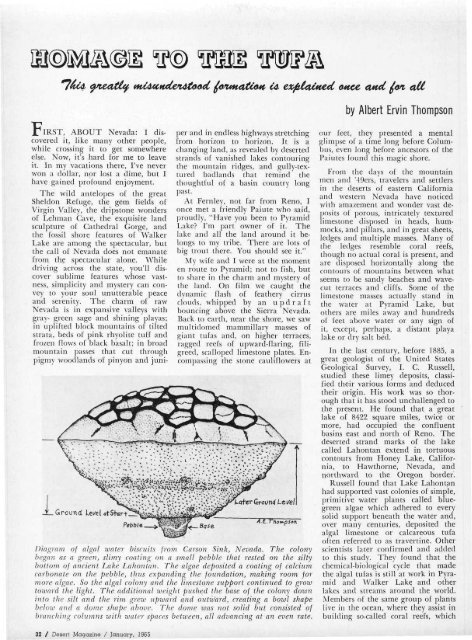desert magazine's special attractions - Desert Magazine of the ...
desert magazine's special attractions - Desert Magazine of the ...
desert magazine's special attractions - Desert Magazine of the ...
Create successful ePaper yourself
Turn your PDF publications into a flip-book with our unique Google optimized e-Paper software.
Homage to <strong>the</strong> Tufa<br />
yieatly ntUattcUMfood fatmattaa it explained once and fan<br />
JTlRST, ABOUT Nevada: I discovered<br />
it, like many o<strong>the</strong>r people,<br />
while crossing it to get somewhere<br />
else. Now, it's hard for me to leave<br />
it. In my vacations <strong>the</strong>re, I've never<br />
won a dollar, nor lost a dime, but I<br />
have gained pr<strong>of</strong>ound enjoyment.<br />
The wild antelopes <strong>of</strong> <strong>the</strong> great<br />
Sheldon Refuge, <strong>the</strong> gem fields <strong>of</strong><br />
Virgin Valley, <strong>the</strong> dripstone wonders<br />
<strong>of</strong> Lehman Cave, <strong>the</strong> exquisite land<br />
sculpture <strong>of</strong> Ca<strong>the</strong>dral Gorge, and<br />
<strong>the</strong> fossil shore features <strong>of</strong> Walker<br />
Lake are among <strong>the</strong> spectacular, but<br />
<strong>the</strong> call <strong>of</strong> Nevada does not emanate<br />
from <strong>the</strong> spectacular alone. While<br />
driving across <strong>the</strong> state, you'll discover<br />
sublime features whose vastness,<br />
simplicity and mystery can convey<br />
to your soul unutterable peace<br />
and serenity. The charm <strong>of</strong> raw<br />
Nevada is in expansive valleys with<br />
gray- green sage and shining playas;<br />
in uplifted block mountains <strong>of</strong> tilted<br />
strata, beds <strong>of</strong> pink rhyolite tuff and<br />
frozen flows <strong>of</strong> black basalt; in broad<br />
mountain passes that cut through<br />
pigmy woodlands <strong>of</strong> pinyon and juni-<br />
per and in endless highways stretching<br />
from horizon to horizon. It is a<br />
changing land, as revealed by <strong>desert</strong>ed<br />
strands <strong>of</strong> vanished lakes contouring<br />
<strong>the</strong> mountain ridges, and gully-textured<br />
badlands that remind <strong>the</strong><br />
thoughtful <strong>of</strong> a basin country long<br />
past.<br />
At Fernley, not far from Reno, I<br />
once met a friendly Paiute who said,<br />
proudly, "Have you been to Pyramid<br />
Lake? I'm part owner <strong>of</strong> it. The<br />
lake and all <strong>the</strong> land around it belongs<br />
to my tribe. There are lots <strong>of</strong><br />
big trout <strong>the</strong>re. You should see it."<br />
My wife and I were at <strong>the</strong> moment<br />
en route to Pyramid; not to fish, but<br />
to share in <strong>the</strong> charm and mystery <strong>of</strong><br />
<strong>the</strong> land. On film we caught <strong>the</strong><br />
dynamic flash <strong>of</strong> fea<strong>the</strong>ry cirrus<br />
clouds, whipped by an updraft<br />
bouncing above <strong>the</strong> Sierra Nevada.<br />
Back to earth, near <strong>the</strong> shore, we saw<br />
multidomed mammillary masses <strong>of</strong><br />
giant tufas and, on higher terraces,<br />
ragged reefs <strong>of</strong> upward-flaring, filigreed,<br />
scalloped limestone plates. Encompassing<br />
<strong>the</strong> stone cauliflowers at<br />
Diagra?n <strong>of</strong> algal zuater biscuits from Carson Sink, Nevada. The colony<br />
began as a green, slimy coating on a small pebble that rested on <strong>the</strong> silty<br />
bottom <strong>of</strong> ancient Lake Lahontan. The algae deposited a coating <strong>of</strong> calcium<br />
carbonate on <strong>the</strong> pebble, thus expanding <strong>the</strong> foundation, making room for<br />
more algae. So <strong>the</strong> algal colony and <strong>the</strong> limestone support continued to grow<br />
toward <strong>the</strong> light. The additional iceight pushed <strong>the</strong> base <strong>of</strong> <strong>the</strong> colony doiun<br />
into <strong>the</strong> silt and <strong>the</strong> rim grew upward and outward, creating a bowl shape<br />
below and a dome shape above. The dome was not solid but consisted <strong>of</strong><br />
branching columns with water spaces between, all advancing at an even rate.<br />
32 / <strong>Desert</strong> <strong>Magazine</strong> / January, 1965<br />
by Albert Ervin Thompson<br />
our feet, <strong>the</strong>y presented a mental<br />
glimpse <strong>of</strong> a time long before Columbus,<br />
even long before ancestors <strong>of</strong> <strong>the</strong><br />
Paiutes lound this magic shore.<br />
From <strong>the</strong> days <strong>of</strong> <strong>the</strong> mountain<br />
men and '49ers, travelers and settlers<br />
in <strong>the</strong> <strong>desert</strong>s <strong>of</strong> eastern California<br />
and western Nevada have noticed<br />
with amazement and wonder vast deposits<br />
<strong>of</strong> porous, intricately textured<br />
limestone disposed in heads, hummocks,<br />
and pillars, and in great sheets,<br />
ledges and multiple masses. Many <strong>of</strong><br />
<strong>the</strong> ledges resemble coral reefs,<br />
though no actual coral is present, and<br />
are disposed horizontally along <strong>the</strong><br />
contours <strong>of</strong> mountains between what<br />
seems to be sandy beaches and wavecut<br />
terraces and cliffs. Some <strong>of</strong> <strong>the</strong><br />
limestone masses actually stand in<br />
<strong>the</strong> water at Pyramid Lake, but<br />
o<strong>the</strong>rs are miles away and hundreds<br />
<strong>of</strong> feet above water or any sign <strong>of</strong><br />
it, except, perhaps, a distant playa<br />
lake or dry salt bed.<br />
In <strong>the</strong> last century, before 1885, a<br />
great geologist <strong>of</strong> <strong>the</strong> United States<br />
Geological Survey, I. C. Russell,<br />
studied <strong>the</strong>se limey deposits, classified<br />
<strong>the</strong>ir various forms and deduced<br />
<strong>the</strong>ir origin. His work was so thorough<br />
that it has stood unchallenged to<br />
<strong>the</strong> present. He found that a great<br />
lake <strong>of</strong> 8422 square miles, twice or<br />
more, had occupied <strong>the</strong> confluent<br />
basins east and north <strong>of</strong> Reno. The<br />
<strong>desert</strong>ed strand marks <strong>of</strong> <strong>the</strong> lake<br />
called Lahontan extend in tortuous<br />
contours from Honey Lake, California,<br />
to Hawthorne, Nevada, and<br />
northward to <strong>the</strong> Oregon border.<br />
Russell found that Lake Lahontan<br />
had supported vast colonies <strong>of</strong> simple,<br />
primitive water plants called bluegreen<br />
algae which adhered to every<br />
solid support beneath <strong>the</strong> water and,<br />
over many centuries, deposited <strong>the</strong><br />
algal limestone or calcareous tufa<br />
<strong>of</strong>ten referred to as travertine. O<strong>the</strong>r<br />
scientists later confirmed and added<br />
to this study. They found that <strong>the</strong><br />
chemical-biological cycle that made<br />
<strong>the</strong> algal tufas is still at work in Pyramid<br />
and Walker Lake and o<strong>the</strong>r<br />
lakes and streams around <strong>the</strong> world.<br />
Members <strong>of</strong> <strong>the</strong> same group <strong>of</strong> plants<br />
live in <strong>the</strong> ocean, where <strong>the</strong>y assist in<br />
building so-called coral reefs, which

















